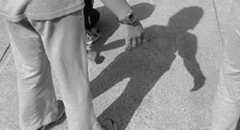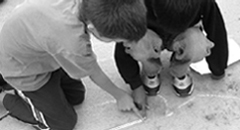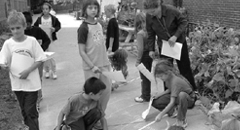
|

|

|
|
||
January-October, 2006
What did we learn from this pilot project?
- Even in this era of No Child Left Behind and increased emphasis on standardized tests scores, nearly everyone who came into contact with this work in the seminar and the institute found the ideas provocative and revitalizing, with some describing them as "an entry point to lasting change," and "revolutionary" and "transformative" to their thinking and practice.
- Through documentation, MLV teachers demonstrated that they were visibly listening to their students. In response, students took greater care to formulate their thoughts and listen to others in return. Documentation also led students (and teachers!) to take more responsibility for their own learning, and incorporated more of the student voice into the assessment process. Showing students documentation of their learning process often resulted in greater student engagement and a higher quality product or performance, regardless of whether the subject matter was student-generated or decreed by state or district content standards.
- New ideas and practices brought into the classroom include: 1) an increased focus for all on what was learned, rather than what was done; 2) making the learning process along with product visible (people new to this work can sometimes overemphasize reflection over content; clearly, both are important); 3) providing multiple perspectives on learning (adult, child, peer) that deepen one's own as well as others' learning (many teachers have begun to include what they have learned alongside student learning in their documentation); and 4) posting photos as well as children's work and words on the walls to increase student interest and nurture a sense of identity as a learning group.
- This work has also led to greater teacher collaboration across disciplines, grades, and specialties (e.g., art with high school math and 6th grade science, music with 3rd grade math, special education with classroom teachers, etc.)
- Four common tensions emerged as teachers grappled with supporting and documenting individual and group learning: 1) balancing content learning and learning about learning; 2) making visible the links between standards and more project-based learning; 3) being purposeful about balancing student- and teacher-directed learning; and 4) connecting learning in the classroom or school to issues and events in the larger community.
- For some schools, this work demonstrated a new and innovative way to use technology in support of student and adult learning. Technology is typically integrated into schools either as a form of distance learning or a tool for quantitative data analysis. Many teachers expanded their use of technology as a way to record, deepen, and make student (and adult) learning visible for the benefit of their own and others' learning.
- Posting documentation on the Web provides a critical resource and memory of the teaching and learning that took place during the grant. The Web documentation helps both MLV teachers and others in their schools (and elsewhere) learn from this work—build on it, reflect on it, critique it, and connect it to other work. Many MLV teachers considered this a difference from other initiatives in which they have been involved.
- Many schools used this work to influence the "culture of learning" for children as well as adults. For example, a kindergarten teacher's documentation on creating a culture of critique in her classroom was used to support another school's efforts to develop a culture of critique among staff.
- Finally, this work has served as a potent reminder to schools that they indeed have a responsibility to be "public"—to share what they learn with others in and outside the school. Many core group members have shared this work with staff in their own or other schools, in the district, at educational conferences, and at an annual documentation studio at Wheelock College.
What challenges did we encounter?
- We underestimated the need to secure more active and visible support from leaders of the 12 MLV schools over the course of the project. After the initial meeting and agreement to participate, many school heads lost touch with the work and their commitment to send four-six additional staff to the summer institute. As a result, we are now expecting a school leader (principal, curriculum coordinator, etc.) to be part of a three-person facilitation team as well as attend a significant part of the summer retreats and two check-ins/year. We will also get much more detailed information about the MLV schools' professional development goals and involvement in other initiatives up front in order to build meaningful links early on with MLV ideas.
- We will conduct much more "on-site" work in the future, while continuing to foster school-to-school connections. We will try to ground many of these meetings in documentation as a way to connect a school's broader learning goals to day-to-day classroom practice.
Documentation serves different purposes at different stages of learning, but it is first and foremost a tool for internal use—an aid to a teacher's or student's reflection and informing future learning. The goal of creating a more public piece of documentation for the exhibition at the MLV Institute and the Web was critical to the learning process in many ways ("the challenge of being very clear was so valuable," was one comment); however, it also led to more of an emphasis on documentation as "display," particularly for the newer members, rather than a tool to support teacher and student learning. In the future, we will make sure to share the small, daily, classroom moves of documentation, or documentation that did not go well, along with the more shaped documentation of longer projects.
- An additional challenge is the common tendency of many, when first introduced to MLV ideas, to focus on documentation as an end itself and forget about "why" they are documenting—what they want to learn and how it relates to supporting individual and group learning. We will make this challenge more visible in the future. Encouraging teachers to identify research questions up front may also help to ground and focus their documentation.
What are the ways in which MLV ideas and practices influenced teaching and learning in pilot phase classrooms and schools?
- Forming new cross-grade and cross-district study groups to continue exploring MLV ideas
- Sharing MLV work (grounded in documentation) at staff retreats and department meetings
- Making MLV a focus for existing "critical friends groups"
- Offering a school-based professional development course, documenting teachers' learning, and sharing it with others in the school through an exhibition and panel discussion
- Special ed department teachers creating documentation to make their students' learning styles visible to regular classroom teachers by sharing it at staff meetings
- Providing an extra free period for teachers to form a professional learning group grounded in the discussion of documentation
- Using protocols and documentation to structure and focus teacher staff meetings on student and teacher learning
- Developing a common language by talking with other school staff about links across programs and initiatives
- Cross-disciplinary collaboration on documenting learning in academic subject areas (e,g., an art teacher and a high school math teacher collaborating on designing and documenting a pre-calculus class to apply mathematical functions to the study of climate change)
- Involving other adults in the classroom (interns, special aides, assistants) in this work
- Conducting bulletin board tours to look for examples of student and teacher learning
- Reviving portfolio practices that have fallen by the wayside so that children can better document their own learning
- Reinvigorating ongoing portfolio practices by forming small student learning groups at the high school level to oversee the collection and reflection process
- Teachers seeing themselves, along with their students, as members of the learning group who make their own learning visible as well as others'
- Creating new rubrics to make student thinking more visible at grade-level and schoolwide science expositions
- Developing capacity for critiquing one's own and others' work at the kindergarten, middle school, and adult staff levels
- Using documentation to resolve problematic behavior in a sensitive, yet public way (as opposed to simply issuing a suspension warning)
- Encouraging students to document their own individual and group powerful moments of learning
- Using MLV ideas to successfully challenge a new school policy about displaying student work in a more evaluative, rather than informative, way
- A principal exploring how to enhance the teacher evaluation process by including another perspective (teacher or administrator) in her observation model
- Redefining the classroom as "a place of research, learning, and teaching in a learning community" and developing a new permission form for parents to reflect this
[Home] [Site Map]